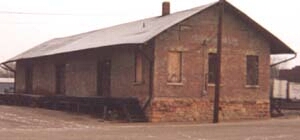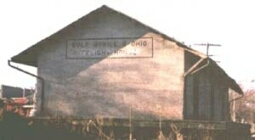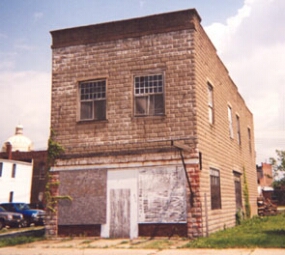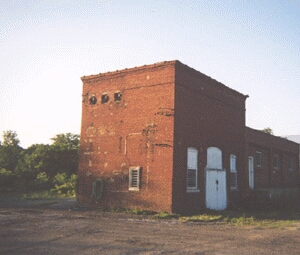 |
|
Marquee Lights of the Lincoln Theater, est. 1922, Lincoln, Illinois |
| w |
|
The information on this page covers four topics:
Summary of Rail History in Lincoln, Illinois Three rail systems and a streetcar line fostered growth and development in Lincoln. The most detailed, extant history of railroads in Logan County, and most likely the main source for subsequent accounts, is Stringer's "Chapter XX: Transportational" in History of Logan County Illinois (1911). An excellent contemporary history of transportation in Lincoln, Illinois, including the railroads and streetcar, is Paul Gleason's Lincoln: A Pictorial History, pp. 20-29. The first railroad here was the Chicago and Alton in 1853. The Chicago and Alton was absorbed by the GM&O in 1947. In 1972 the GM&O merged with the Illinois Central, forming the Illinois Central Gulf (ICG), which became AMTRAK in 1971. For more detailed history of the GM&O, see Jim's Railroad Page and the Web site of the GM&O Historical Society (Web site addresses in Sources Cited below). A second railroad was the Illinois Central (IC). Most likely the IC was descended from two other companies: the Pekin, Lincoln, and Decatur Railroad, which was completed through Lincoln and Logan County in 1871 (Gleason, Lincoln: A Pictorial History, p. 20) and the Havana, Mason City, Lincoln, and Eastern Railroad, completed in 1873 (Gleason, p. 20). See the Illinois Central Historical Society Web site (address below) for more information. |
|||||||||||
|
A third railroad was the Illinois Traction System (interurban), called the Illinois Terminal (ITS) after 1937 (Nancy Gehlbach, Our Times, fall 1998, pp. 2-3). ITS passenger service lasted from 1907 to 1956; ITS freight Service ended in 1962 (Gehlbach, pp. 2-3). In their prime technology, interurban trains were able to reach 60 mph (Gehlbach, p. 4). According to a map published in Paul Gleason's Lincoln: A Pictorial History (p. 23), the ITS connected Peoria, Lincoln, Bloomington, Urbana, Champaign, Danville, Decatur, Springfield, and Carlinville, Hillsboro, Staunton, Edwardsville, and St. Louis. (A separate ITS line connected Princeton, LaSalle, Ottawa, Joliet, and Chicago.) Lincoln also had a streetcar system provided by another company. |
Figure 6.1: Electric Locomotive of the ITS
|
||||||||||
The fall 1998 issue of Our Times contains a history of the streetcar system in Lincoln, Illinois. The Lincoln Electric Street Railway Company existed from "Christmas Day of 1891" to May 15, 1928. The station was at 211 S. Kickapoo, the power house on Clinton St. The streetcar originally "ran to the new Woodlawn subdivision, the Illinois Asylum for Feebleminded Children [later the Lincoln State School & Colony and then the Lincoln Developmental Center], and the Illinois Central depot on North Kickapoo St." In 1907, the line was extended from the Asylum over a mile to the Chautauqua grounds.
|
|||||||||||
|
Abraham Lincoln, the Railroad, and the Town He Named The naming of this town for and by Abraham Lincoln was a result of his growing law practice: "In the 1850s, the Illinois legislature chartered railroads, and many of them soon began construction. These events increased litigation over issues of right of way, stock subscriptions, fencing, and damages to real property. Lincoln generally supported the development of railroads all over the state, but that did not prevent him from opposing the railroad companies in the courtroom. He became involved in railroad litigation and represented individuals nearly as often as railroad corporations. The Illinois Central Railroad secured his legal services more often than any other railroad, and Lincoln opposed them in only a few cases" (Web site of the Illinois Historic Preservation agency, address below). Like many of his contemporaries, Lincoln was proud of American technology, including railroads: "Russia has called on us to show her how to build steam-boats and railroads -- while in the older parts of Asia, they scarcely know that such things as S.Bs & RR.s. exist" (Abraham Lincoln, Second Lecture on Discoveries and Inventions, Jacksonville, Illinois, February 11, 1859). The story of how Lincoln, Illinois, was named has been told and re-told by various local historians, including Logan County's most prominent historian, Judge Lawrence Stringer. His account is a primary source used in a 56-paragraph christening history found in the 1953 Centennial Edition of the Lincoln Courier. That account is described as "unfinished," and the author is unnamed. The following is a summary of Paul E. Gleason's account, previously published in the defunct www.lincoln-il.com Web site: 1. August 24, 1853: Founders and developers had Abraham Lincoln draw up the papers to designate him as their attorney in the course of selling lots in the newly established town. Virgil Hickox, the oldest of the founders at 47, was "a friend and neighbor" of Attorney Abraham Lincoln, age 44, of Springfield. Abraham Lincoln was also an attorney for the Alton and Sangamon Railroad (before it became the Chicago and Alton Railroad), as it was acquiring land through Logan County. The founders asked Lincoln to bestow his name on the new town, and he consented. 2. August 27, 1853: Abraham Lincoln allegedly attended the sale of lots for the new town, occurring at Broadway and Sangamon Streets adjacent to the railroad tracks. According to legend, after the sale, Abraham Lincoln split open a watermelon from a nearby stack of them, squeezed the juice into a cup, and poured it on the ground, christening the town in his name. The railroad transported Mr. Lincoln through Lincoln, Illinois, on an unknown number of occasions. He must have used it on his business and political trips to Bloomington and Chicago, and the last two occasions were 1. November 21, 1860. President-elect Lincoln spoke to citizens from the rear of a train taking him to Chicago on his way to Washington, D.C. The New York Herald on November 22 printed the brief speech (six sentences), which is reproduced in Paul Gleason's Lincoln. Lincoln thanked the crowd for its "kindness toward me" and asked to be excused from political comment (Gleason, p. 16). 2. May 3, 1865. Lincoln's funeral train stopped at the train
depot at approximately 7:00 a.m. On May 4th the New York Herald
printed this report: "Lincoln, Ill. contains between two and three
thousand inhabitants. Lincoln had a direct interest in its origin. The
depot is handsomely draped. Ladies, dressed in white and black, are
singing as we pass under a handsomely constructed arch, on each side of
which is a picture of the deceased President with the motto "With Malice to
none, with Charity for all." The national and State flags are
prominently displayed, and a profusion of evergreens, with black and white
drapings make up the artistic and appropriate arrangements" (Raymond Dooley,
ed., The Namesake Town: A Centennial History of Lincoln, Illinois,
p. 29). |
|||||||||||
|
The Railroad and the Abraham Lincoln Legend The GM&O Railroad descended from the Chicago
and Alton Railroad, whose location in Logan County led to the founding of
Lincoln, Illinois. In honor of Abraham Lincoln,
the GM&O named two of its five passenger "streamliner" trains the
Abraham Lincoln
and
the Ann Rutledge. The Abraham Lincoln was described as
the world's most modern train (with the Lincoln tavern). These trains,
running from 1935 into the 1950s, provided premium passenger
service, featuring "observation parlor
cars, drawing-room parlor cars, buffet-lounge cars, dining cars, smoking
cars with individual reclining seats. Both had stewardess and
registered nurses," according to the Web site of the National Railroad
Museum (address below). See this Web site for more detailed information about the GM&O streamliners,
including depiction of the trains' "drumheads" (logo-symbols). |
|||||||||||
|
Figure 6.5: The Locomotive of the GM&O Abraham Lincoln (Chicago, heading south, July, 1971). Source: www.umcycling.com/amtrak.htm |
Figure
6.6: The Caboose of the GM&O Abraham Lincoln (no place
or date given). Source: |
||||||||||
|
Figure 6.7: Tail Section of Observation Car (from Dave Randall and Gene Glendinning, "Abe 'n Annie," Part 1, GM&O Historical Society News 1979, p. 17. The caption of the photo in part reads, "Tail section was reminiscent of one's living room with individual wing chairs, comfortable couches and reading lamps.") |
|||||||||||
|
The 103-A was not the original locomotive of the Abraham Lincoln. The Web site of the National Railroad Museum (address below) describes the original as first named the "Lady Baltimore, a unique 4-4-4 originally designed for the B&O [Baltimore & Ohio] Royal Blue service [and it] was transferred to the Alton and assigned to the yet to be inaugurated Abraham Lincoln. Dedication of the locomotive occurred on May 15, 1935, at Springfield, IL. The first run of the Abraham Lincoln occurred on July 1, 1935." In response to my inquiry about the Abraham. Lincoln locomotive, I received the following detailed history on March 6, 2002, from Mr. Gene Glendinning, treasurer of the GM&O Historical Society. He was unaware that I did not know that the 103-A was not the original locomotive of the Abraham Lincoln. He describes the original: "I believe the diesel you're referring to was the B&O's box cab, which, along with two units the Santa Fe received from Electro Motive Co., then of Cleveland, the first road engines produced. It operated between Jersey City and Washington D.C. in the B&O's Royal Blue service before being transferred to the Alton to head the Abraham Lincoln in 1935. It was numbered 50. In 1937 a slanted nose was fabricated and added to the unit for added crew safety. The 50 continued to head the Abe until the early 1940's when the slanted nose was removed and no. 50 was paired with a B&O E6 (originally no. 52) as a "B" unit which lasted for the remainder of the war years. Around 1945, as the Alton began receiving its six EMD E7's, no. 50 was shopped and emerged as the no. 1200. It held down a local passenger run and local freight runs out of Bloomington before being used for a while in the 1950's as the power for the single GM&O suburban run between Chicago and Joliet. The unit was then retired and delivered to Pilot Bros., McCook, Illinois for scrap. The unit was saved from scrap and delivered
to the National Transportation Museum at St. Louis, where it rests today. It was refurbished and painted in its original B&O dress. The
museum is near Kirkwood and easily accessible. I hope this answers your
question. Let me know if there's anything else I might provide. Regards, Figure 6.8 below is an artistic drawing of the1935 Abraham Lincoln showing its original B&O 50 locomotive (Gleason and Beaver, Logan County Pictorial History, p. 8). (The drawing below has been enlarged through computer technology.) The right side of the light on the top clearly shows the number 50, and the drawing also depicts the slanted front that had been added in 1937 when this unit was modified for the Abraham Lincoln. Figure 6.9 below shows a 1982 photo of this
locomotive at the National Museum of Transportation before restoration.
Again, the right side of the light shows the distinctive 50, but the slanted
front had been removed in its post-Abraham Lincoln years.
This photo is a cropped version of a full photo at a Web page by S. Berliner
(Web site address below). Mr. Berliner's Web site has
a detailed history of this locomotive and a second photo of the B&O 50 prior
to its restoration. |
|||||||||||
|
Figure 6.8: Drawing of the 1935 B&O 50
|
|
||||||||||
|
|
|||||||||||
|
The GM&O, the Illinois Central, and the Illinois Traction System passenger and freight services were crucial to business and industry in Lincoln. One of the largest commodities produced in Lincoln, Illinois, by weight and volume was sand and gravel. Below is one of the most distinctive reminders of this industry. The following locomotive
photo was obtained from the Web site of Mr. Don Ross (address below). According to Mr. Ross, this locomotive is a "44 ton locomotive
built by Davenport in 1940, #2301, for Morrell Meat Packing Co. In
1975 it was donated to the Monticello Railroad Museum." Mr. Ross's Web
site shows a second diesel locomotive used by the Lincoln Sand & Gravel Co.
Many Lincolnites who visited Lincoln Lakes will fondly remember the
strange-looking workhorse below. I recall it was very noisy.
|
|||||||||||
|
In addition to the
following structures, a building that served as a streetcar depot still
stands at the edge of Old Union Cemetery with a photo of it at
8. Map
& Photos of Lincoln Memorial Park, the Historic Cemeteries, & Nearby Sites.
Figure
6.11: Picture Postcard of the |
|||||||||||
|
Figure
6.12: The GM&O
Passenger Depot |
Figure 6.13: The Passenger Depot |
||||||||||
|
|
|
||||||||||
|
Figure
6.16: The GM&O Freight
House (Depot) |
Figure:
6.17: The GM&O Freight House (Depot)
|
||||||||||
|
(from Stu Wyneken photo in Figure 6.16) |
Figure 6.19: A Freight Train Speeds from the North, Passing Through Town Next to the Old GM&O Freight House (DLH photo, 8:30 a.m., 6-9-02) |
||||||||||
|
Figure 6.20: The ITS (interurban) Passenger and Freight Depot (1909) at 216 S. Chicago Street (note the courthouse dome at mid left). (DLH photo, 6-02)
|
Figure 6.21: Rare 1913 Picture Postcard of ITS Depot (right) and Passenger Car (center) Another scene at 216 S. Chicago Street. The Commercial Hotel is immediately behind the depot. The Lincoln House hotel is visible in the background. At left is lumber stored on the yard of Spellman Lumber Company. |
||||||||||
|
One spur track, possibly two, ran between the depot and the hotel. Lincolnite Willie Aughton says that from this spur track train cars could unload coal for the hotel. He notes that the metal arm seen at the right front of the building supported an awning (shown in Figure 6.21). Historian Nancy Gehlbach writes that passengers' luggage could be moved from the depot to the hotel by way of a "second-floor runway between the two buildings" (Gehlbach, "Riding the Rails," p. 2). A close view of the full photo reveals an old wagon wheel in the right-front window. |
|||||||||||
|
Figure 6.22: The ITS Freight Depot, Car Barn, and Power Station at End of Chicago Street (This view faces South Kickapoo Street.) |
|||||||||||
|
|
Figure 6.24: Fixtures (ceramic?) Used to Transmit Electricity Through Power Lines to the Locomotive (see Figure 6.1) |
||||||||||
|
Figure 6.25: Switch House on South Kickapoo Street (DLH photo, 7-01)
The above facility was was used to direct loaded cars from the Lincoln Sand and
Gravel to the main tracks. The locomotive in Figure 6.10 was one of two
that transported sand and gravel cars to the main line. Nancy Gehlbach
refers to this building as "the little interlocking plant on the road to
Lincoln Lakes. . . . Manned by the Lincoln Sand and Gravel crews, it
was lined for the interurban except when a LS&G train was crossing.
Lincoln Sand and Gravel shipped partly over the ITS, which had an active
freight division." She says that the interurban tracks were removed in
the summer of 1978 ("Riding the Rails," p. 3). |
|||||||||||
|
Sources Cited Amtrak 4: www.umcycling.com/amtrak.htm Berliner, S., Web site: http://home.att.net./~Berliner-Ultrasonics/boxcbo50.html Dooley, Raymond, ed. The Namesake Town:
A Centennial History of Lincoln, Illinois. Lincoln, IL: Gehlbach, Nancy. "Riding the Rails: Interurbans, Streetcars, and Steam Trains." Our Times, fall 1998. Gleason, Paul E. Lincoln, A Pictorial History. St. Louis, MO: G. Bradley Publishing, 1998 Gleason, Paul E., and Paul J. Beaver, Logan County Pictorial History.
St. Louis, MO: G. Bradley GM&O Diesel Roster (Web site without
identification): GM&O Historical Society Web site: http://www.gmohs.org/ Illinois Central Historical Society Web site: http://icrrhistorical.org/ Illinois Historic Preservation Agency: http://www.papersofabrahamlincoln.org/narrative_overview.htm Jim's Railroad Page: http://www.trainweb.org/jimrail/history.html Lincoln Evening Courier Centennial Edition, Wednesday, August 26, 1953, section two, page 4.
Maxwell, William. "The Man in the Moon" in All the Days and Nights:
The Collected Stories. NY: National Railroad Museum: www.nationalrrmuseum.org/ Monticello Railway Museum: http://prairienet.org/mrm/homepage.html National
Transportation Museum:
http://www.museumoftransport.org/. Click on "Come on Let's Get Randall, Dave, and Gene Glendenning, "Abe 'n
Annie," Part 1, GM&O Historical Society News, 1979. Ross, Don, Web site: http://donross.railspot.com/dr115.htm (Scroll to Lincoln Sand and Gravel Co.) Stringer, Lawrence B. "Chapter XX: Transportational" in History of Logan
County Illinois (1911). |
|||||||||||
| Home |
Lincoln's Special Events |
Preview of Growing up Near Route 66 in Lincoln, Illinois |

























